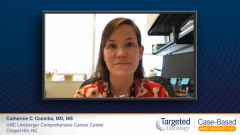
Initial Impression and Prognosis of a Patient with R/R CLL
Catherine Coombs, MD, MS, introduces the case of a patient with relapsed/refractory CLL and shares her impressions on the patient’s initial presentation.
Episodes in this series

Catherine C. Coombs, MD, MS: Hi, I am Catherine Coombs. I’m an assistant professor at the University of North Carolina, and I am excited to be here today to talk about some important therapy decisions for patients with chronic lymphocytic leukemia [CLL]. Today we are going to start with a case, this is a 72-year-old man diagnosed with CLL at age 70. He had previously been treated with venetoclax and obinutuzumab upon his initial diagnosis at age 70. He presented to his oncologist complaining of recent low-grade fevers, increased shortness of breath, and overall increased fatigue. His past medical history is notable for a stroke at age 65; hypertension, which is controlled with medications; hypercholesterolemia, which is controlled on atorvastatin. His social history is that he is a retired farmer. He is widowed and he likes to spend time with his kids and grandkids.
His physical exam was notable for normal vital signs, though he did have lymphadenopathy and a palpable spleen. Laboratory findings are pertinent for an elevated white blood cell count of 115,000. His hemoglobin is 9.2 [g/dL]. His platelets are 90. His creatinine clearance is 70 mL/min. His molecular testing shows that his flow is consistent with his underlying diagnosis of CLL and that there is a population that is positive for CD5, CD19, and CD23. His beta-2 microglobulin is 3 mg/L, his IGHV mutational status is unmutated. He also has no mutations in TP53, but he does have a deletion 11q. His ECOG performance status is 1.
The prognosis for this patient, it is hard to give an exact number. We do have really informative prognostic models for CLL, the largest being the CLL-IPI [CLL-International Prognostic Index]. However, this was largely developed prior to the wide introduction of novel agents. And so though that can stratify patients into low- to high-risk groupings, the overall estimates for survival are likely underestimations, given the wide availability of venetoclax, in addition to BTK [Bruton tyrosine kinase] inhibitors. Patients seem to be living a lot longer than they used to, which has been corroborated by large population-based studies. I think the model is useful though in pointing out adverse prognostic features. The 2 most heavily weighted prognostic features for individuals with CLL, the first one is the presence or absence of TP53 aberrations. That could be the presence or absence of a TP53 mutation on next-generation sequencing, or the presence or absence of a deletion 17p on FISH [fluorescence in situ hybridization], karyotype testing, or both. That is the most important prognostic finding. We know that individuals with TP53 aberrations tend to have the shortest survival compared to other individuals with CLL. I think that difference is less so with the introduction of novel agents, given that these agents work quite effectively in this subpopulation, though there are some differences that I’ll point out later in this discussion.
The other very important prognostic finding is the IGHV mutation status. It’s actually worse to have an unmutated IGHV. I think of that as the patient’s B cell is a bit more primitive, given that a mature B cell typically undergoes this process of somatic hypermutation. What we know from clinical studies is that individuals with unmutated IGHV typically have a shorter time to first therapy and often do not have as good of a response to therapy compared to individuals who have the mutation.
Taking a look at those prognostic findings, the patient has the unmutated IGHV, which is a poor prognostic finding, but he is wild type with TP53. Overall, I would say his prognosis is a little worse than the average patient with CLL in this situation, but he is likely still expected to live many years from a CLL perspective, hopefully.
Transcript edited for clarity.









































